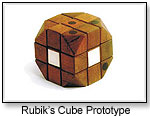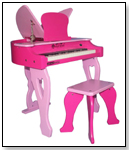|
|
Patents in the Toy and Game Industry: Part I How a Patent Portfolio Bolstered LEGO’s Bottom Line
Because patents protect physical or electronic components from copyists, patents provide the strongest IP protection for the “guts” of a toy. Patents allow the patent holder to exclude all others from making, using or selling a product in the U.S. without the holder’s consent. Because of this intrinsic value, patents also serve useful business and strategic functions. Without patents, companies become vulnerable in the marketplace on multiple fronts. With patents, a company can effectively set a platform for future development and growth. SCRAMBLING WITHOUT A PATENT In the 1980s, the Ideal Toy Company licensed rights to a rotating cubelet puzzle and trademarked the name Rubik’s Cube.  The trademark was valuable, but it was insufficient to block the sale of inexpensive copycat puzzles that flooded the U.S. during the height of the Rubik’s Cube’s popularity. While the imitations could not be sold as Rubik’s Cube, they could be put on store shelves to compete with the branded puzzle at a lower cost. The trademark was valuable, but it was insufficient to block the sale of inexpensive copycat puzzles that flooded the U.S. during the height of the Rubik’s Cube’s popularity. While the imitations could not be sold as Rubik’s Cube, they could be put on store shelves to compete with the branded puzzle at a lower cost. This is because the inventor of the cube, Hungarian sculptor Erno Rubik, failed to file a U.S. patent for the mechanical components of his invention. Though Rubik did quite well by licensing his toy to Ideal, and Ideal holds the distinction of selling the most popular puzzle worldwide, both parties would have fared far better if they were able to stop the import of cheaper imitations via a U.S. patent. A properly crafted patent would have forced imitators to cease selling puzzles having a similar cubelet structure, or to pay a royalty to use the patent. In fact, rather than being able to exclude others from making and selling such puzzles, Ideal’s successor (CBS) actually found itself on the receiving end of a lawsuit on a patent for a cube puzzle held by yet another company. With no patent rights of its own to use as a bargaining chip, CBS had no choice but to fight an expensive and prolonged legal battle that went back and forth between the lower court and appeals court for the better part of a decade. Eventually, CBS was absolved of patent wrongdoing for its ubiquitous 3 x 3 x 3 puzzle. Nevertheless, both the inventor (Rubik) and the licensee (Ideal/CBS) would have benefited from patent protection for the cube at the outset. SETTING A BRICK FOUNDATION In contrast, the humble and iconic LEGO building block had been patented for decades. While the basic patent on the interlocking blocks has long expired, the LEGO companies had the foresight to protect improvements on the toy as LEGO products evolved over the past 50 years.  These include patents on the modular heads of LEGO people, the swivel and joint assemblies, joining rods, and electronic virtual models of the physical pieces. LEGO continues to maintain a comprehensive set of utility and design patents. The technology for producing LEGO blocks is not complicated, but imitators historically were kept at bay from selling low-cost, competing products by a set of patents that guarded the toy line. These include patents on the modular heads of LEGO people, the swivel and joint assemblies, joining rods, and electronic virtual models of the physical pieces. LEGO continues to maintain a comprehensive set of utility and design patents. The technology for producing LEGO blocks is not complicated, but imitators historically were kept at bay from selling low-cost, competing products by a set of patents that guarded the toy line.LEGO is now involved in diverse areas, including amusement parks and video gaming, each having roots in the simple plastic building module. Had LEGO been forced to fend off early imitators, it is questionable whether the company would have the same hold in the several markets it enjoys today. HOW PATENTS PROTECT GROWTH As toys include more electronic and technical components, patents are bound to become more instrumental in the toy industry. One school of thought says that toy trends fade quickly, and that the pace of the toy industry would make a patented technology obsolete well before a patent is even examined. However, the methodical and consistent building of a patent portfolio, such as that surrounding LEGO, demonstrates how patents can play an important role in a toy maker’s growth. This stands in contrast to the economic and legal tribulations of the Rubik’s Cube. Finally, as the LEGO example illustrates, patents can confer exclusive rights to a product in its entirety or to a component of the whole. As a result of these exclusive provisions, patents can be used as leverage to structure a partnering arrangement or to obtain funding. Both of these secondary uses can prove very helpful in tough economic times, which will be addressed next in this series. In the initial stages of developing a product: 1. Consider whether any operational aspects of the toy (mechanical or electronic components) could potentially be protected by a utility patent. Or, if the toy is an improvement of an older product, could an aspect of the improved product be protected by a utility patent? Keep in mind that a patentable feature need not be the entire product but can be a component of the whole. 2. If there is such an operational feature in Step 1, do a cursory patentability search to determine whether that feature has already been invented. A good place to start this search is the USPTO’s website. Go to http://patft.uspto.gov/ and search both the database of issued patents and published patent applications using the website’s search tools. 3. Regardless of whether the new product or improvement includes operational features that can be protected by a utility patent, also consider the possibility of a design patent or a trademark to provide some intellectual property protection for the appearance or branding of the toy.  Writer's Bio: Susan Perng Pan is partner in the Washington, D.C., office of the global intellectual property firm, Sughrue Mion PLLC. She litigates multi-party complex patent disputes before several U.S. federal district courts, the U.S. International Trade Commission, and the U.S. Federal Trade Commission. Her practice also includes preparing and prosecuting patent applications, appeals and interferences before the U.S. Patent and Trademark Office. She may be contacted at span (at) sughrue.com. Read more articles by this author Writer's Bio: Susan Perng Pan is partner in the Washington, D.C., office of the global intellectual property firm, Sughrue Mion PLLC. She litigates multi-party complex patent disputes before several U.S. federal district courts, the U.S. International Trade Commission, and the U.S. Federal Trade Commission. Her practice also includes preparing and prosecuting patent applications, appeals and interferences before the U.S. Patent and Trademark Office. She may be contacted at span (at) sughrue.com. Read more articles by this author |
| |||||||||||||||||||||||||||||||||
Disclaimer Privacy Policy Career Opportunities
Use of this site constitutes acceptance of our Terms of Use.
© Copyright 2025 PlayZak®, a division of ToyDirectory.com®, Inc.



